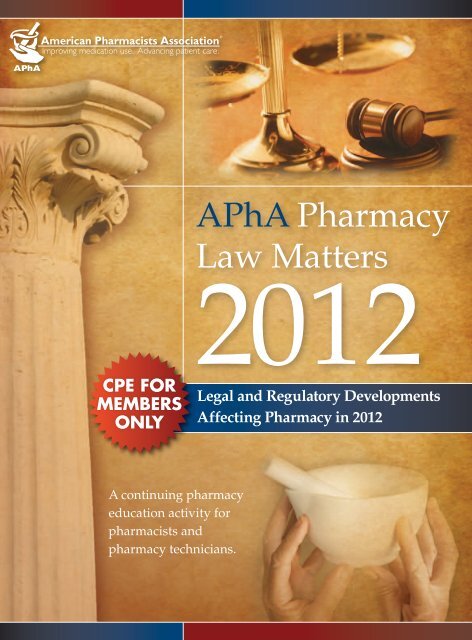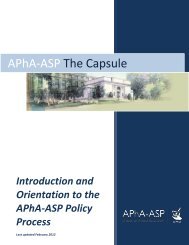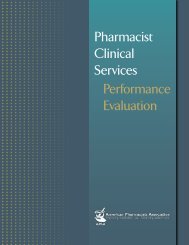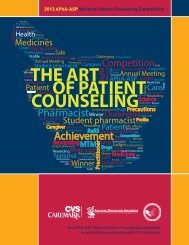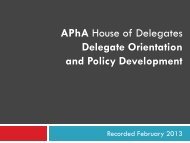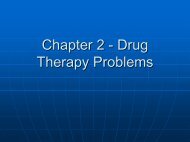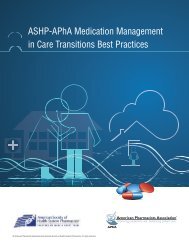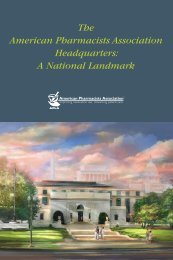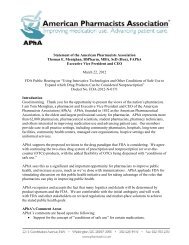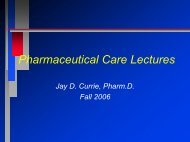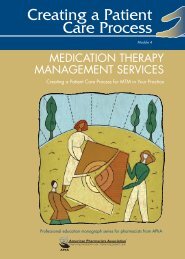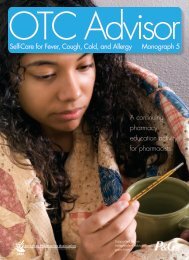Download - Library - American Pharmacists Association
Download - Library - American Pharmacists Association
Download - Library - American Pharmacists Association
Create successful ePaper yourself
Turn your PDF publications into a flip-book with our unique Google optimized e-Paper software.
APhA Pharmacy<br />
Law Matters<br />
2012<br />
CPE for<br />
members<br />
only<br />
Legal and Regulatory Developments<br />
Affecting Pharmacy in 2012<br />
A continuing pharmacy<br />
education activity for<br />
pharmacists and<br />
pharmacy technicians.
Pharmacy Law Matters<br />
Legal and Regulatory Developments Affecting Pharmacy in 2012<br />
A continuing pharmacy education activity for pharmacists and pharmacy technicians.<br />
Provider: <strong>American</strong> <strong>Pharmacists</strong> <strong>Association</strong><br />
Target audiences: <strong>Pharmacists</strong> and Pharmacy Technicians<br />
Release date: January 1, 2013<br />
Expiration date: January 1, 2016<br />
Learning level: 1<br />
ACPE numbers: pharmacists: 0202-0000-13-101-H03-P; pharmacy<br />
technicians: 0202-0000-13-101-H03-T<br />
CPE credit: 2 hours (0.2 CEUs)<br />
Fee: You must be a member of APhA to claim credit for this activity.<br />
There is no fee associated with this activity for APhA members.<br />
Advisory Board<br />
Jay Campbell, BSPharm, JD<br />
Executive Director<br />
North Carolina Board of Pharmacy<br />
Chapel Hill<br />
Marcie Bough, PharmD<br />
Senior Director, Government Affairs<br />
<strong>American</strong> <strong>Pharmacists</strong> <strong>Association</strong><br />
Washington, DC<br />
Development<br />
This home-study CPE activity was developed by the <strong>American</strong><br />
<strong>Pharmacists</strong> <strong>Association</strong>.<br />
This publication was prepared by Judy Crespi Lofton, MS, of JCL<br />
Communications, in consultation with the Government Affairs<br />
staff, on behalf of the <strong>American</strong> <strong>Pharmacists</strong> <strong>Association</strong>.<br />
Disclosure<br />
Mr. Campbell, Ms. Crespi Lofton, and APhA’s Government Affairs<br />
and editorial staff declare no conflicts of interest or financial interests<br />
in any product or service mentioned in this activity, including<br />
grants, employment, gifts, stock holdings, and honoraria.<br />
Accreditation Information<br />
The <strong>American</strong> <strong>Pharmacists</strong> <strong>Association</strong> is accredited<br />
by the Accreditation Council for Pharmacy<br />
Education as a provider of continuing pharmacy education<br />
(CPE). The ACPE Universal Activity Numbers assigned to<br />
this activity by the accredited provider are 0202-000-13-101-H03-P<br />
and 0202-000-13-101-H03-T.<br />
To obtain 2.0 contact hours (0.2 CEUs) of CPE credit for<br />
this activity, you must complete the Assessment, the Learning<br />
Evaluation, and the Activity Evaluation. A Statement of Credit will<br />
be awarded for a passing grade of 70% or better on the Assessment.<br />
You will have two opportunities to successfully complete<br />
the CPE Assessment. <strong>Pharmacists</strong> and pharmacy technicians who<br />
successfully complete this activity before January 1, 2016, can<br />
receive CPE credit. Your Statement of Credit will be available upon<br />
successful completion of the Assessment, Learning Evaluation,<br />
and Activity Evaluations and will be stored in your ‘My Training<br />
Page’ and on CPE Monitor for future viewing/printing.<br />
Learning Objectives<br />
At the completion of this activity, pharmacists and technicians<br />
will be able to:<br />
1. Describe the outcome of Supreme Court rulings in 2012 that<br />
have an impact on the practice of pharmacy.<br />
2. Describe pending legislation and legislation that became law in<br />
2012 that affects the profession of pharmacy.<br />
3. Explain activities that took place in 2012 by the Centers for<br />
Medicare & Medicaid Services to implement the Affordable<br />
Care Act and other regulations that impact pharmacy.<br />
4. Describe regulatory activities by the Food and Drug Administration<br />
affecting pharmacists, including potential revisions to<br />
the drug paradigm.<br />
5. Discuss regulatory activities by the Drug Enforcement Administration,<br />
including those pertaining to disposal of controlled<br />
substances and the electronic prescribing of controlled<br />
substances.<br />
©2013 by the <strong>American</strong> <strong>Pharmacists</strong> <strong>Association</strong>. All rights reserved. Printed in the U.S.A.<br />
60 PharmacyToday • January 2013<br />
www.pharmacytoday.org
Pharmacy law matters: Legal<br />
and regulatory developments<br />
affecting pharmacy in 2012<br />
<strong>American</strong> <strong>Pharmacists</strong> <strong>Association</strong><br />
Abstract<br />
Objective: To explain legal, regulatory, and judicial developments<br />
in 2012 that have an impact on the practice of pharmacy.<br />
Summary: Key developments in 2012 included the U.S.<br />
Supreme Court’s decision to uphold most of the Affordable<br />
Care Act (ACA); activities to implement ACA, including ongoing<br />
activities to support pharmacist roles on the health<br />
care team; the 2012 reauthorization of the Prescription Drug<br />
User Fee Act; potential revisions to FDA’s paradigm of drug<br />
categories; and other activities, including those by CMS and<br />
DEA.<br />
Conclusion: Laws, regulations, and judicial decisions have<br />
an important influence on the practice of pharmacy. Pharmacist<br />
involvement in advocacy efforts that communicate the<br />
value of the pharmacist to decision makers and other stakeholders<br />
is critical.<br />
Keywords: Affordable Care Act, Centers for Medicare &<br />
Medicaid Services, Drug Enforcement Administration, Food<br />
and Drug Administration, health care reform, integrated<br />
care, Medicare, patient care services, pharmacy law, Supreme<br />
Court.<br />
Pharmacy Today. 2013(Jan);19(1):59–71.<br />
3. Which of the following provisions was included in the fifth<br />
reauthorization of the Prescription Drug User Fee Act (PDUFA<br />
V)?<br />
a. New pathways for drug importation<br />
b. Track-and-trace provisions that track individual products to<br />
the pharmacy level<br />
c. Reclassification of all hydrocodone-containing products to<br />
Schedule II<br />
d. Provisions focused on standardizing risk evaluation and<br />
mitigation strategy (REMS) programs<br />
4. Which of the following is a correct statement about FDA’s<br />
Nonprescription Safe Use Regulatory Expansion initiative<br />
and revisions to the drug paradigm?<br />
a. It would create a new category of drugs.<br />
b. It would allow certain drugs that would otherwise require a<br />
prescription to be sold without a prescription under conditions<br />
of safe use.<br />
c. Any final recommendations for modifying the drug paradigm<br />
must be voted on by Congress.<br />
d. The program would implement greater standardization to<br />
REMS programs.<br />
5. Which law(s) allows FDA to create a safer process for disposing<br />
of unused controlled substances?<br />
a. The Affordable Care Act<br />
b. The Safe Doses Act<br />
c. The Secure and Responsible Drug Disposal Act<br />
d. PDUFA IV and V<br />
Preassessment questions<br />
Before participating in this activity, test your knowledge by answering<br />
the following questions. These questions also will be part of the<br />
CPE exam.<br />
1. Which of the following Partnership for Patients programs are<br />
intended to improve transitions of care and reduce hospital<br />
readmissions?<br />
a. The Community-based Care Transitions Program and Hospital<br />
Engagement Networks (HENs)<br />
b. The Community-based Care Transitions Program and STAR<br />
ratings<br />
c. HENs and expanded medical staff privileges<br />
d. STAR ratings and expanded medical staff privileges<br />
2. Which of the following was a requirement of CMS’s 2013 call<br />
letter to Part D plans?<br />
a. Completion of a comprehensive medication review (CMR)<br />
within 90 days of a targeted beneficiary’s enrollment<br />
b. Addition of the CMR completion rate as a display measure in<br />
2013 for plan ratings<br />
c. Limitation of the diseases for which beneficiaries can be<br />
targeted for medication therapy management services<br />
d. Part D plan assessment of beneficiary eligibility on a<br />
monthly basis<br />
The year 2012 was pivotal for many legislative and regulatory<br />
developments that affect the practice of pharmacy.<br />
The U.S. Supreme Court’s decision to largely uphold the<br />
2010 Affordable Care Act (ACA; PL 111-148) was a critical<br />
moment for the law. The development of key components<br />
of the law required for full implementation have moved<br />
forward, and parts of the law that advance pharmacy<br />
practice continued to be implemented. These developments,<br />
along with other legislative, regulatory, and judicial<br />
activities, continue to redefine and shape the practice<br />
of pharmacy.<br />
This article, which is current as of November 1, 2012,<br />
describes a wide range of activities that affect pharmacy<br />
practice, including implementation of ACA, new legislation,<br />
and new regulations from CMS, FDA, and DEA. Other<br />
issues affecting pharmacy are listed in Table 1. 1,2<br />
APhA has been integral in advocating on behalf of<br />
pharmacists regarding these activities to educate decision<br />
makers about the value of pharmacists’ services and the<br />
role of pharmacists in improving patient care.<br />
www.pharmacist.com january 2013 • PharmacyToday 61
Table 1. Other legislative and regulatory issues affecting pharmacy<br />
Recent<br />
Topic<br />
developments<br />
Fraud, waste, and<br />
abuse<br />
ACOs and patient-centered<br />
medical homes<br />
Activity related to<br />
the federal budget<br />
sequester<br />
Compounding<br />
HIPAA (PL 104-191) first established a national Health Care<br />
Fraud and Abuse Control Program. ACA increased funding<br />
for auditing activities and created greater access to pharmacy<br />
records for auditors. See the 2011 Pharmacy Law<br />
Matters for a discussion of these provisions.<br />
Work continues on integrated care models and shared savings<br />
opportunities. CMS is looking at potential future payment<br />
options. APhA continues to advocate for pharmacist<br />
payment within evolving models.<br />
The Budget Control Act of 2011 (PL 112-25) raised the debt<br />
ceiling to allow the U.S. government to borrow more money<br />
to meet its current obligations. This law created the “super<br />
committee” as one of several complex mechanisms for<br />
controlling spending. The super committee was unable to<br />
reach agreement on how to reduce the deficit according to<br />
the timeline required in the law. As a result, a mechanism in<br />
the law known as the “sequester” is scheduled to take effect<br />
beginning January 2013.<br />
In the wake of a fungal meningitis outbreak that originated<br />
with contaminated injectable steroids states, Congress and<br />
FDA are reevaluating regulation of compounding pharmacies.<br />
Key issues for pharmacy<br />
In 2012, CMS continued its focus on data-mining<br />
efforts to identify fraud waste and abuse. More<br />
information is available from CMS at www.cms.<br />
gov/Outreach-and-Education/Medicare-Learning-Network-MLN/MLNProducts/downloads/<br />
Fraud_and_Abuse.pdf.<br />
As of October 2012, 154 ACOs were serving<br />
more than 2.4 million Medicare patients. <strong>Pharmacists</strong><br />
can help ACOs and other integrated<br />
models achieve quality measures by improving<br />
clinical quality and reducing costs.<br />
In the sequester, the Office of Management and<br />
Budget must implement across-the-board cuts<br />
in most programs, split between defense and<br />
nondefense, to reach a $1.2-trillion target. Medicare<br />
provider reimbursements could be reduced<br />
by 2%. Medicaid and Social Security are exempt<br />
from cuts. Congress is considering additional<br />
legislation to modify the mandatory cuts under<br />
the sequester. APhA is closely monitoring this<br />
activity.<br />
In 2012, the Verifying Authority and Legality In<br />
Drug Compounding Act of 2012 (H.R. 6584) and<br />
the S.A.F.E. Compounding Drugs Act of 2012<br />
(H.R. 6638) were introduced to address regulation<br />
of pharmacy compounding. APhA is actively<br />
engaged in ongoing dialogue with Congress and<br />
FDA as this issue evolves.<br />
Abbreviations used: ACA, Affordable Care Act; ACO, accountable care organization; HIPAA, Health Insurance Portability and Accountability Act of 1996.<br />
Source: References 1 and 2.<br />
ACA: Judicial update<br />
ACA (PL 111-148) aims to expand health care coverage, improve<br />
quality, and control costs. ACA is designed to achieve<br />
these goals by reforming the health care insurance market<br />
and encouraging innovation in the provision of health care<br />
services. Examples of insurance reforms include requirements<br />
for individual health insurance coverage, essential health benefits,<br />
and expanding eligibility for Medicaid to all individuals<br />
younger than 65 years with incomes below 133% of the<br />
federal poverty level. Innovations include activities driven by<br />
the Center for Medicare & Medicaid Innovation (CMMI). The<br />
law includes numerous provisions of interest to pharmacists<br />
that affect issues such as improvements to Medicare Part D<br />
medication therapy management (MTM) programs, the Independence<br />
at Home Demonstration project, accountable care<br />
organizations, medical homes, and transitions of care. 3<br />
ACA requires individuals to purchase health insurance<br />
that meets defined standards of coverage or face a penalty—a<br />
requirement known as the “individual mandate.” Shortly after<br />
its passage, various parties challenged ACA’s individual mandate<br />
in federal court based primarily on the argument that<br />
Congress could not force individuals to purchase a product<br />
under the Interstate Commerce Clause. Challenges to the law<br />
eventually made their way to the U.S. Supreme Court, and on<br />
June 28, 2012, the Supreme Court published its long-awaited<br />
ruling. The court upheld ACA’s individual mandate as a constitutional<br />
exercise of Congress’s power to tax and only struck<br />
down a provision in the law that could strip existing Medicaid<br />
funding from states that do not comply with the law’s Medicaid<br />
expansion requirements.<br />
The court ruled that the individual mandate provision<br />
was constitutional under Congress’s authority to tax rather<br />
than its power to regulate commerce. Concerning ACA’s expansion<br />
of Medicaid, the court ruled Congress went too far<br />
with a provision that would make states risk losing all of their<br />
Medicaid funding for not complying with ACA’s expansion of<br />
Medicaid eligibility.<br />
Implementation of ACA and other<br />
CMS activities<br />
Following the Supreme Court ruling on ACA’s constitutionality,<br />
there has been renewed focus on the implementation of<br />
the law’s provisions and on political opposition to the law. For<br />
example, on July 11, the House of Representatives voted 244 to<br />
62 PharmacyToday • January 2013<br />
www.pharmacytoday.org
185 to repeal the law (H.R. 6079). The Senate is unlikely to vote<br />
on the issue. In the states, some governors have said that they<br />
do not plan to follow ACA’s Medicaid expansion.<br />
APhA will continue its efforts to safeguard pharmacists’<br />
interests in Congress and work with federal agencies and<br />
states as they consider and execute various regulations to implement<br />
the law.<br />
Establishing state purchasing insurance exchanges<br />
State-based health insurance exchanges will allow individuals<br />
and small businesses to compare and purchase health insurance<br />
coverage and enroll in a plan that meets their needs. Insurance<br />
plans offered through the exchanges must provide, at<br />
minimum, “essential health benefits” that have been defined<br />
by the Department of Health & Human Services (HHS). Details<br />
about the essential health benefits can be found at www.<br />
healthcare.gov/news/factsheets/2012/11/ehb11202012a.html.<br />
In addition, exchanges will provide information and education<br />
services, such as helping patients determine whether<br />
they are eligible for tax credits for private insurance or health<br />
programs like the Children’s Health Insurance Program.<br />
The exchanges are required to be fully operational by January<br />
1, 2014. HHS will evaluate the readiness of the exchanges<br />
1 year before the launch dates. States are required by ACA to<br />
submit a blueprint of their plans for developing the exchanges<br />
to HHS by November 16, 2012. These plans should address issues<br />
such as the structure of the exchange and its governance,<br />
consumer assistance and outreach, information technology<br />
infrastructure, and financing of the exchange. However, as of<br />
August 2012, only 15 states had established exchanges. Seven<br />
states declared that they would not create an exchange; others<br />
continue to evaluate their options. 4<br />
CMMI<br />
ACA established CMMI to encourage novel payment and service<br />
delivery models to assess their effects on cost and quality<br />
of care for existing programs, such as Medicare and Medicaid.<br />
The law requires that MTM services be among the models<br />
tested. In addition, CMMI is focused on transitions of care, reducing<br />
hospital readmissions, improving quality, and reducing<br />
costs. CMMI is directed to rapidly scale up models that are<br />
demonstrated to be successful.<br />
Currently, CMMI has many programs, including the<br />
Health Care Innovation Awards, Partnership for Patients, and<br />
Hospital Engagement Networks (HENs) (more information<br />
available at www.innovations.cms.gov).<br />
The Health Care Innovation Awards invest up to $1 billion<br />
to support local innovation aimed at improving quality of care<br />
and lowering costs. The awards are intended to 5 :<br />
■■<br />
Engage a broad set of innovation partners to identify and<br />
test new care delivery and payment models that originate<br />
in the field and that produce better care, better health, and<br />
■■<br />
■■<br />
reduced cost.<br />
Identify new workforce development and deployment<br />
models, including training and education to support new<br />
models.<br />
Support innovators who can rapidly deploy care improvement<br />
models (within 6 months of award) through new<br />
ventures or expansion of existing efforts to new populations<br />
of patients. Wherever possible, innovators should<br />
work with other public and private sector partners.<br />
Two rounds of Health Care Innovation Awards were announced<br />
in May and June 2012. Pharmacy and pharmacists<br />
played integral roles in at least 15 of the organizations that won<br />
awards. As the pharmacy community becomes more familiar<br />
with these projects, APhA expects to identify additional programs<br />
that integrate pharmacist services, especially related<br />
to transitions of care, medication reconciliation, adverse drug<br />
events, and reducing drug-related hospital readmissions. Each<br />
project will be monitored for measurable improvements in<br />
quality of care and cost savings. 5<br />
Launched in April 2011, the Partnership for Patients is a<br />
nationwide public–private partnership that supports physicians,<br />
nurses, pharmacists, and other clinicians working to<br />
make patient care safer and to support effective transitions<br />
of patients from hospitals to other settings. The Community-<br />
Based Care Transitions Program (a program of Partnership for<br />
Patients) tests models for improving care transitions to reduce<br />
hospital readmissions. 6<br />
As part of Partnership for Patients, hospitals across the<br />
country will have new resources and support through HENs.<br />
HENs are being developed to make health care safer and less<br />
costly by targeting and reducing the millions of preventable<br />
injuries and complications from health care–acquired conditions.<br />
In 2012, CMMI awarded $218 million to 26 state, regional,<br />
national, or hospital system organizations to develop<br />
HENs. HENs will help develop programs that are already reducing<br />
health care–acquired conditions and are increasingly<br />
focused on preventing drug-related readmissions and adverse<br />
drug events and improving transitions of care. Such work<br />
aims to share information with other hospitals and health care<br />
providers so that communities can learn from each other as<br />
part of an evolving health care system. 6<br />
APhA is actively engaged with CMMI and the initiatives<br />
described above to be a resource and increase awareness of<br />
the role that pharmacists can play in improving patient outcomes,<br />
meeting quality measures, and improving care transition<br />
activities. 7,8<br />
APhA/<strong>American</strong> Society of Health-System <strong>Pharmacists</strong><br />
transitions of care resources. To better define pharmacists’<br />
roles in supporting medication safety throughout transitions<br />
of care, in 2012, APhA and the <strong>American</strong> Society of Health-<br />
System <strong>Pharmacists</strong> released a white paper, Improving Care<br />
Transitions: Optimizing Medication Reconciliation (www.<br />
pharmacist.com/sites/default/files/files/2012_improving_<br />
care_transitions.pdf). The white paper provides a comprehensive<br />
overview of the medication reconciliation process during<br />
transitions in care, its effect on patient care and outcomes, and<br />
how pharmacists can contribute to the improvement of this<br />
process through MTM.<br />
The white paper advocates that pharmacists should take a<br />
leadership role in collaborating with other health professionals<br />
in the coordination and implementation of medication reconciliation.<br />
A publication containing best practice highlights<br />
also is being developed. 9<br />
www.pharmacist.com january 2013 • PharmacyToday 63
Public–private partnerships: The Million Hearts Campaign<br />
Launched by HHS and led by CDC and CMS, Million Hearts is a national<br />
public–private partnership aimed at preventing 1 million heart<br />
attacks and strokes in the United States over 5 years.<br />
The campaign encourages the use of its ABCs mnemonic: A,<br />
aspirin for people at high risk; B, blood pressure control; C, cholesterol<br />
control; and S, stopping smoking.<br />
APhA and other pharmacy organizations and corporations have<br />
partnered with HHS to work toward the Million Hearts goal. Numerous<br />
federal agencies are involved in the campaign to provide staff<br />
and funding. As part of the program, CDC announced the $2 million<br />
Pharmacy Outreach Project, which will enroll pharmacists to<br />
provide advice and support to patients with high blood pressure.<br />
CMS will award $485 million over 5 years to 10 states to encourage<br />
Medicaid beneficiaries to participate in chronic disease prevention<br />
programs. 10–12<br />
In support of the Million Hearts initiative, the APhA Foundation<br />
launched the Pharmacy Blood Pressure Challenge in June 2012.<br />
The challenge is a screening and education initiative that encourages<br />
pharmacists to help prevent and control high blood pressure<br />
in their patients by performing screenings and providing education.<br />
<strong>Pharmacists</strong> who engage in this program will be able to report their<br />
impact on the APhA Foundation’s Pharmacy Blood Pressure Challenge<br />
website (http://millionhearts.aphafoundation.org). Aggregated<br />
information collected through this site will help to demonstrate<br />
the impact of pharmacists in their communities. 13<br />
In addition, in September 2012, APhA and the APhA Foundation<br />
announced that they have joined the new pharmacy-based hypertension<br />
program, Team Up. Pressure Down (http://millionhearts.hhs.<br />
gov/resources/teamuppressuredown.html). 14<br />
APhA urges members, including independent pharmacists,<br />
regional and national chain pharmacists, and student pharmacists,<br />
to embrace these opportunities to help patients get screened and<br />
take action to help manage cardiovascular health.<br />
Part D–related provisions for 2013<br />
ACA codified into law more robust MTM program requirements<br />
for Medicare Part D plans. Building on current programs,<br />
requirements in ACA offer a set of MTM services to<br />
targeted Medicare beneficiaries that include, at minimum,<br />
strategies to improve adherence to prescription medications<br />
or other goals. Specifically, Part D MTM programs and strategies<br />
must include an annual comprehensive medication review<br />
(CMR) delivered person to person or using telehealth<br />
technologies by a licensed pharmacist or other qualified provider<br />
and follow-up interventions as indicated by findings<br />
of the annual medication review or the targeted medication<br />
enrollment. Services may be provided person to person or<br />
using telehealth technologies.<br />
Part D plan sponsors also must assess, at least quarterly,<br />
medication use by individuals who are at risk but not enrolled<br />
in the MTM program, including individuals who have<br />
experienced a transition in care (e.g., a hospitalization or stay<br />
in a skilled nursing facility), if the drug plan sponsor has access<br />
to that information. They also must automatically enroll<br />
targeted beneficiaries in the MTM program, including beneficiaries<br />
identified in the quarterly assessment, and permit<br />
beneficiaries to opt out of enrollment in the MTM program.<br />
CMS’s 2013 call letter to Part D plans included several additional<br />
requirements, including 15 :<br />
■■<br />
Offering to provide targeted beneficiaries a CMR as soon<br />
■■<br />
■■<br />
■■<br />
as possible after enrollment into the MTM program. The<br />
rate of targeted beneficiaries who complete CMRs will<br />
be used as a quality measure for Part D plans. In 2013,<br />
information about CMR completion will be available as<br />
a display measure for beneficiaries to view, and it’s anticipated<br />
that in 2014, this measure will be used in the<br />
plan’s overall quality STAR rating. (STAR ratings are information<br />
about a Part D plan’s quality that are provided<br />
to beneficiaries.)<br />
Using more than one approach to reach all eligible targeted<br />
beneficiaries.<br />
Expanding beneficiary targeting to include Alzheimer<br />
disease, end-stage renal disease, and atrial fibrillation, as<br />
well as target at least five of nine core chronic conditions<br />
Leveraging effective MTM programs to improve plan<br />
STAR ratings.<br />
ACA also directed CMS to develop a standardized format<br />
for CMR documentation for beneficiaries enrolled in Part D<br />
MTM programs. The standardized documentation includes<br />
three components: a beneficiary cover letter, a medication action<br />
plan, and a personal medication list (PML). The format<br />
of these documents is similar to MTM forms currently in use<br />
(i.e., those included in the core elements model from APhA<br />
and the National <strong>Association</strong> of Chain Drug Stores Foundation).<br />
For example, the PML is similar to the patient medication<br />
record described in the core elements model. 16,17 Medicare<br />
Part D plans will be required to use the standardized<br />
format beginning January 1, 2013.<br />
The standardized format’s written summary requires<br />
certain activities during the CMR to complete the documentation.<br />
These include discussion of beneficiaries’ concerns<br />
regarding their drug therapy; collection of the purpose and<br />
instructions for using their medications; review of their<br />
medications, including prescription drugs, nonprescription<br />
drugs, and supplements; and engaging beneficiaries in managing<br />
their drug therapy. 15 For a more complete review of the<br />
Part D information and revisions for 2013, see APhA’s issue<br />
brief on www.pharmacist.com.<br />
Issues affecting long-term care facilities<br />
Citing concerns about potential conflicts of interest, in October<br />
2011, CMS proposed a Medicare rule that would require<br />
long-term care consultant pharmacists to be “independent”<br />
from long-term care pharmacies and drug manufacturers<br />
and distributors. Under the proposal, long-term care facilities<br />
(LTCFs) also would be prohibited from contracting for<br />
consultant pharmacy services, with a long-term care pharmacy<br />
subsidiary created to provide reorganized services. 18<br />
CMS published a final rule in April 2012 that differed<br />
substantially from the initial proposal. In the final rule, CMS<br />
decided against requiring long-term care consultant pharmacists<br />
to be “independent” and instead requested comments<br />
to help CMS determine a more comprehensive approach to<br />
address inappropriate formulary decisions and the use of<br />
chemical restraints in long-term care. CMS encouraged the<br />
long-term care industry to voluntarily adopt the following<br />
changes to increase transparency and specifically requested<br />
feedback on them 18 :<br />
64 PharmacyToday • January 2013<br />
www.pharmacytoday.org
■■<br />
Separate contracting for long-term care consulting services<br />
from dispensing and other pharmacy services<br />
■■<br />
Pay a fair market rate for consultant pharmacist services<br />
■■<br />
Require consultant pharmacists to disclose any potential<br />
conflicts of interest to LTCFs or execute an integrity<br />
agreement to increase transparency<br />
CMS delayed the implementation of short-cycle dispensing<br />
in LTCFs by 1 year to January 1, 2013. After that date,<br />
dispensing will be limited to 14-day increments for solid<br />
oral doses of covered brand-name drugs, with some exclusions.<br />
The reporting requirement for unused drugs in increments<br />
of 7 days or less will be waived. Also, total cost<br />
sharing for copayments cannot be more than what would<br />
be imposed without the provision (additional information<br />
available at www.pharmacist.com/cms-releases-medicarerevisions-2012).<br />
Legislative developments in 2012<br />
A number of legislative actions in 2012 will have an important<br />
influence on the practice of pharmacy, including Prescription<br />
Drug User Fee Act (PDUFA) reauthorization, the<br />
Safe Doses Act, and MTM legislation.<br />
PDUFA reauthorization<br />
On July 9, 2012, President Barack Obama signed the Food and<br />
Drug Administration Safety and Innovation Act (PL 112-144),<br />
which included the fifth reauthorization of PDUFA (PDUFA<br />
V). PDUFA allows FDA to collect fees from drug manufacturers<br />
to help fund the drug application review process and<br />
must be reauthorized every 5 years. PDUFA V also creates<br />
new user fee programs for generic drugs, biosimilars (generic<br />
biologics), and medical devices. The user fee program<br />
for biosimilars would apply to products approved under the<br />
abbreviated pathway created by ACA.<br />
As required by PDUFA IV (which was passed in 2007),<br />
in 2010 and 2011, FDA held numerous public meetings and<br />
conducted discussions with pharmaceutical manufacturers<br />
and stakeholder groups to develop recommendations for<br />
PDUFA V, and Congress based the reauthorization process<br />
on FDA’s recommendations. APhA worked with FDA, Congress,<br />
and other stakeholders throughout the regulatory and<br />
legislative process to educate stakeholders about provisions<br />
important to pharmacists. At the same time, APhA worked<br />
to exclude potential items that would have been harmful to<br />
pharmacists. For example, APhA was involved in activity<br />
on multiple fronts urging senators to vote against any drug<br />
importation amendments; in the end, one drug importation<br />
amendment was voted on but did not pass the Senate. 19,20<br />
PDUFA V addresses many aspects of the drug development,<br />
review, and approval process. Issues of the greatest<br />
interest to pharmacy included enhancing and modernizing<br />
FDA’s drug safety system. Several important PDUFA provisions<br />
build on the stakeholder feedback that gathered during<br />
the reauthorization process, including input from APhA focused<br />
on improving and standardizing risk evaluation and<br />
mitigation strategy (REMS) programs. APhA’s recommendations<br />
to improve REMS programs are outlined in the 2009<br />
and 2011 REMS white papers available on www.pharmacist.<br />
com. REMS program improvements and other important<br />
activities that support FDA’s efforts are outlined in the FDA<br />
and manufacturer PDUFA V agreement that was submitted<br />
to Congress in January 2012. Additional provisions include<br />
using FDA’s postmarket surveillance and Sentinel Initiative<br />
to evaluate drug safety issues and ensuring that resources<br />
are in place to manage pharmacogenomic information. Specific<br />
information in the agreement is available at www.fda.<br />
gov/downloads/forindustry/userfees/prescriptiondruguserfee/ucm270412.pdf.<br />
Other key provisions of the law that affect pharmacy include<br />
20 :<br />
■■<br />
Requirements related to drug shortages, including early<br />
notification of FDA by manufacturers of potential shortages<br />
and an HHS-maintained public list of all drugs ex-<br />
■■<br />
periencing shortages.<br />
Authorization for HHS to develop guidance on interoperability<br />
standards for prescription drug monitoring programs.<br />
■■<br />
Increased manufacturer-level track-and-trace provisions.<br />
Provisions that were considered but not included in the<br />
final bill include 20 :<br />
■■<br />
Track-and-track provisions that would reach the pharmacy<br />
level.<br />
■■<br />
Reclassification of all hydrocodone-containing products<br />
from Schedule III to Schedule II.<br />
In addition, the law authorizes the development of guidance<br />
for standards for interoperability of prescription drug<br />
monitoring programs and a study on drug labeling by electronic<br />
means.<br />
Progress of MTM legislation introduced in 2011<br />
Congress continues to consider legislation introduced in<br />
2011 that would increase patient access to MTM services: the<br />
Medication Therapy Management Benefits Act of 2011 (H.R.<br />
8) and its companion bill, the Medication Therapy Management<br />
Empowerment Act of 2011 (S. 274). Either bill would<br />
make several improvements to the Medicare Part D MTM<br />
program. Improvements would include increasing the number<br />
of diseases for which beneficiaries may be targeted for<br />
services, requiring plan sponsors to offer any willing pharmacy<br />
in its network the opportunity to provide services, and<br />
providing additional quality-based incentive payments to<br />
pharmacies that deliver MTM services.<br />
Although no significant action has been taken on the bills<br />
since they were introduced in 2011, they do offer an avenue to<br />
continue dialogue with Congressional staff about the value<br />
that pharmacists provide to the health care team. In addition,<br />
as of October 2012, there were 61 cosponsors in the House<br />
and 17 cosponsors in the Senate.<br />
APhA believes that it is crucial that pharmacists continue<br />
their advocacy efforts to communicate the value of pharmacy<br />
services. <strong>Pharmacists</strong> are encouraged to communicate with<br />
their legislators and to join APhA’s key contact network. See<br />
www.pharmacist.com/advocate for more information on<br />
how to advocate on behalf of pharmacists and www.pharmacist.com/advocacy-key-contacts-sign<br />
to sign up as a key<br />
contact.<br />
www.pharmacist.com january 2013 • PharmacyToday 65
The Safe Doses Act<br />
On September 25, 2012, Congress passed the Safe Doses Act,<br />
and it became law in October (PL 112-186). The bill seeks to<br />
fight medical theft and protect patients from receiving stolen<br />
and mishandled medical products that have been resold<br />
into the marketplace, typically through gray- or black-market<br />
channels. 22<br />
Before the Safe Doses Act, federal law did not distinguish<br />
the theft of medication from the theft of other products. The<br />
law creates a distinction and provides:<br />
■■<br />
Increased sentences for robbing pharmacies of controlled<br />
■■<br />
■■<br />
■■<br />
■■<br />
■■<br />
substances.<br />
Increased sentences for those who steal medical products.<br />
Enhanced penalties for the “fences” who knowingly obtain<br />
stolen medical products for resale into the supply<br />
chain.<br />
Increased sentences when harm occurs (i.e., instances in<br />
which injury or death results from using a stolen substance<br />
or the defendant is used by an organization in the<br />
supply chain).<br />
Application of the Racketeer Influenced and Corrupt Organizations<br />
(RICO) law, which helps equip law enforcement<br />
with additional tools, to the theft of medical products.<br />
Restitution to victims injured by stolen medical products.<br />
Other regulatory activities<br />
Other 2012 regulatory activities that affect pharmacy practice<br />
include those from FDA, CMS, DEA, and the White House<br />
Office of National Drug Control Policy (ONDCP).<br />
FDA potential revisions to drug paradigm<br />
In February 2012, FDA announced that it is considering revisions<br />
to nonprescription drug classification. In the proposed<br />
new paradigm, FDA would approve certain drugs for nonprescription<br />
use under “conditions of safe use.” Similar to<br />
REMS programs, this new paradigm concept fits into the<br />
overall drug safety continuum by allowing more flexible access<br />
to drugs that otherwise would remain prescription only<br />
(Figure 1).<br />
Such conditions could include intervention by a pharmacist<br />
or use of innovative technologies before purchase of<br />
the product. FDA posed more than 20 questions for feedback<br />
and accepted comments until May 7, 2012. APhA is a leader<br />
in the dialogue on this issue and has highlighted eight key<br />
focus areas for discussion regarding the new drug paradigm<br />
(Table 2). 23<br />
FDA has regulatory authority to continue the discussion<br />
on this issue. The agency continues to evaluate comments<br />
received from public hearing and engage in dialogue with<br />
stakeholders. Ongoing developments with a potential new<br />
paradigm may have important implications for the roles of<br />
pharmacists in supporting patient self-care. 24 As of October<br />
2012, FDA is moving forward with this effort through the<br />
Figure 1. Potential new drug regulation paradigm being considered by FDA: Creating more flexibility on the drug safety continuum to<br />
benefit patients and public health<br />
Abbreviation used: REMS, risk evaluation and mitigation.<br />
Source: Reference 23.<br />
66 PharmacyToday • January 2013<br />
www.pharmacytoday.org
Nonprescription Safe Use Regulatory Expansion (NSURE)<br />
initiative and aims to clarify misinformation and questions<br />
about what is being considered. FDA is working with the<br />
Brookings Institution to explore a variety of NSURE topics.<br />
CMS rule on medical staff privileges<br />
A CMS final rule that was published in May 2012 and effective<br />
as of July 2012 broadens the concept of hospital medical<br />
staff to allow hospitals to grant privileges to nonphysicians<br />
(including pharmacists) in accordance with state law and<br />
within their state scope of practice.<br />
In the rule’s executive summary, CMS notes, “This<br />
change will clearly permit hospitals to allow other practitioners<br />
(e.g., APRNs [advanced practice registered nurses], PAs<br />
[physician assistants], pharmacists) to perform all functions<br />
within their scope of practice.” The impact of this rule’s expansion<br />
of the medical staff concept eventually may be widespread,<br />
and pharmacy is looking at potential opportunities<br />
that may result. 25<br />
CMS issues stage 2 “meaningful use” criteria<br />
CMS “meaningful use” criteria are requirements for the use<br />
of electronic health records with which eligible health care<br />
providers must comply to earn incentive payments as a provision<br />
of “the stimulus” law of 2009. Although pharmacists<br />
are not included within the definition of eligible professionals,<br />
through the Pharmacy e-Health Information Technology<br />
Collaborative (www.pharmacyhit.org), APhA continues to<br />
advocate the importance of pharmacists being connected<br />
and how pharmacists can help physicians and hospitals meet<br />
meaningful use requirements. Integration of pharmacists in<br />
the EHR infrastructure is critical for pharmacists throughout<br />
the health care system.<br />
The program is divided into three stages. Stage 1, which<br />
began in 2011, set the basic functionalities that must be included<br />
in electronic health records. Stage 2 increases health<br />
information exchange between providers and promotes<br />
patient engagement by giving patients secure online access<br />
to their health information. Stage 3 will continue to expand<br />
meaningful use objectives to improve health care outcomes.<br />
Criteria for stage 2 were released in September 2012 and<br />
became effective in November 2012. 26 The final rule for stage<br />
2 included the following:<br />
■■<br />
Providers have more time to meet stage 2 criteria (until<br />
■■<br />
■■<br />
2014 instead of 2013).<br />
Nearly all of the stage 1 core and menu objectives are retained<br />
for stage 2. The “exchange of key clinical information”<br />
core objective from stage 1 was reevaluated in favor<br />
of a more robust “transitions of care” core objective in<br />
stage 2, and the “provide patients with an electronic copy<br />
of their health information” objective was removed and<br />
replaced by a “view online, download, and transmit”<br />
core objective.<br />
A new core objective for hospitals was included: requiring<br />
automatic tracking of medications from order to administration<br />
using assistive technologies in conjunction<br />
with an electronic medication administration record. Release<br />
of the final stage stage 2 rule sets the stage for continued<br />
dialogue as CMS considers stage 3 requirements.<br />
Table 2. APhA’s key focus areas for a new drug paradigm<br />
Area<br />
Evidence and clinical<br />
experience<br />
Public input<br />
Consistent definitions and<br />
processes<br />
Communication<br />
technology<br />
Use of practice algorithms<br />
Ability to bill for services<br />
Provider education<br />
New paradigm authority<br />
Source: Reference 23.<br />
Comments<br />
As currently described, APhA<br />
agrees that the approval of any<br />
product in the new paradigm<br />
would need to be based on science,<br />
clinical evidence of efficacy,<br />
and patient safety in actual use.<br />
An opportunity must exist for<br />
public input on any sponsor’s<br />
proposal for a product with<br />
conditions of safe use.<br />
The process for drug availability<br />
through conditions of safe use<br />
must be defined in a uniform and<br />
standardized process.<br />
Pharmacist–patient care<br />
activities could be communicated<br />
through phone calls and faxes.<br />
However, expanding use of<br />
health information technology<br />
infrastructure and electronic<br />
health records would be more<br />
efficient and effective.<br />
A pharmacist–patient intervention<br />
as part of conditions of safe<br />
use to determine appropriate<br />
dispensing should be built upon<br />
consensus-based, best-practice<br />
algorithms for pharmacists to<br />
implement and communicate with<br />
other providers.<br />
Clinical services required<br />
to dispense products with<br />
conditions of safe use must be<br />
valued by the sponsors, payers,<br />
or consumers who derive the<br />
benefit of those services. APhA<br />
encourages FDA to maintain<br />
a system that incorporates<br />
such mechanisms. Billing<br />
initiated by pharmacists and<br />
administrative processes must<br />
be straightforward and use<br />
standardized mechanisms.<br />
Education about a new paradigm<br />
must focus on the availability<br />
of a product, targeted patient<br />
population, processes and<br />
logistical requirements of the<br />
program, and resource materials<br />
for the pharmacist.<br />
APhA supports pursuing broad<br />
and general authority through<br />
appropriate legislative and/or<br />
regulatory processes.<br />
www.pharmacist.com january 2013 • PharmacyToday 67
DEA activities<br />
Disposal of unused controlled substances. The Secure and<br />
Responsible Drug Disposal Act of 2010 (PL 111-273) became<br />
law in October 2010 to create a safer process for disposing<br />
of unused controlled substances. This law amends the Controlled<br />
Substances Act to allow the attorney general to develop<br />
drug disposal programs and allows LTCFs to dispose<br />
of drugs on behalf of their residents. DEA continues to work<br />
on proposed regulations to implement this law. Until regulations<br />
are in place, DEA will continue to sponsor National<br />
Prescription Drug Take-Back Days. These take-back days are<br />
intended to improve options for medication disposal and reduce<br />
the amount of unused medications that could be misused,<br />
abused, or diverted. 27<br />
<strong>Pharmacists</strong> are encouraged to share information about<br />
the drug take-back days with their patients and work with<br />
local law enforcement to increase awareness of these events<br />
in their community. The DEA National Take-Back Initiative<br />
website provides information on upcoming events. In addition,<br />
more information on drug disposal is available at<br />
the SMARxT Disposal website (www.smarxtdisposal.net/<br />
index.html).<br />
e-Prescribing of controlled substances. On March 31,<br />
2010, DEA issued an interim final rule for the e-prescribing<br />
of controlled substances (EPCS). Beginning June 1, 2010, appropriately<br />
credentialed prescribers were able to e-prescribe<br />
Schedule II through V controlled substances. On August 1,<br />
2012, DEA identified three entities that may certify e-prescribing<br />
systems as meeting DEA security standards. To<br />
date, a limited number of prescribers and pharmacies have<br />
been certified to issue and process e-prescriptions for controlled<br />
substances. DEA provided answers to frequently<br />
asked questions regarding the development and implementation<br />
of the EPCS rule.<br />
ONDCP 2012 strategy update<br />
The Obama Administration’s first National Drug Control<br />
Strategy, published in 2010, provided new direction for efforts<br />
to reduce illicit drug use and its negative effects in the<br />
United States. The strategy established and promoted evidence-based<br />
public health and safety initiatives focusing on<br />
key areas such as substance abuse prevention, treatment, and<br />
recovery.<br />
The 2012 National Drug Control Strategy, released on<br />
April 17, builds on the 2010 plan and provides a review of<br />
the progress made since the original strategy was released<br />
and continues to promote a balanced national drug control<br />
policy. Key activities include 28 :<br />
■■<br />
Strengthening efforts to prevent drug use.<br />
■■<br />
Seeking early intervention opportunities in health care.<br />
This activity includes initiatives that may affect pharmacy,<br />
such as (1) expanding prescription drug monitoring<br />
programs and promoting links among state systems and<br />
to electronic health records and (2) increasing prescription<br />
return/take-back and disposal programs.<br />
■■<br />
Integrating treatment into mainstream health care.<br />
■■<br />
Breaking the cycle of drug use and crime, delinquency,<br />
■■<br />
and incarceration.<br />
Disrupting drug production and trafficking.<br />
■■<br />
Strengthening international partnerships.<br />
■■<br />
Improving information systems.<br />
Supreme Court decision: Douglas v.<br />
Independent Living Center of Southern<br />
California<br />
In 2008, the California <strong>Pharmacists</strong> <strong>Association</strong>, pharmacies,<br />
other health care providers, and patients in California filed<br />
suit in federal court to argue that steep California Medicaid<br />
reimbursement cuts violated federal law. They argued that<br />
the drastic cuts would effectively force pharmacies and other<br />
providers out of the Medicaid program, harming Medicaid<br />
patient access to quality care in violation of the federal patient<br />
access law.<br />
The lawsuit, captioned Douglas v. Independent Living Center<br />
of Southern California, reached the Supreme Court in 2012.<br />
The court was not asked to rule on the merits of the suit but<br />
rather to decide whether private citizens such as providers<br />
and Medicaid patients could sue a state for actions inconsistent<br />
with federal law under the Supremacy Clause. (The<br />
Ninth Circuit Court had previously ruled that providers had<br />
standing to sue over reimbursement rate cuts and blocked<br />
the Medicaid cuts.) In February 2012, the Supreme Court sent<br />
the case back to the Ninth Circuit Court to reconsider its decision<br />
in light of new information described in the Supreme<br />
Court’s opinion.<br />
APhA and several other pharmacy associations supported<br />
the Supreme Court’s actions because it preserves health<br />
care providers’ ability to challenge Medicaid reimbursement<br />
cuts. 29<br />
Conclusion<br />
This article presents an overview of legislative, regulatory,<br />
and judicial actions in 2012 that affect pharmacy practice.<br />
The Supreme Court decision to uphold ACA played an important<br />
role in stimulating regulatory implementation of the<br />
law. Other legislative and regulatory developments at FDA,<br />
CMS, and DEA continue to shape the practice of pharmacy.<br />
At all levels, it is critical for pharmacists to become involved<br />
in efforts to educate policy makers about the value pharmacists<br />
provide to patient outcomes, health care teams, and the<br />
overall health care system.<br />
APhA helps pharmacists, student pharmacists, pharmacy<br />
technicians, and pharmaceutical scientist members and<br />
other stakeholders remain aware of and engaged in a variety<br />
of ongoing national developments that are important to<br />
the pharmacy profession and pharmacists’ role on the health<br />
care team. APhA offers a comprehensive review of legislative<br />
and regulatory issues and provides numerous tools and<br />
resources for pharmacists who wish to advocate on behalf<br />
of their profession. Visit www.pharmacist.com/advocate for<br />
more information and ideas for taking action.<br />
Resources<br />
■■<br />
APhA. Advocacy: www.pharmacist.com/advocate; key contacts<br />
■■<br />
■■<br />
sign-up: www.pharmacist.com/advocacy-key-contacts-sign<br />
Brookings NSURE workshop: www.brookings.edu/<br />
events/2012/11/08-nsure-initiative-event<br />
CMS. CMMI: http://innovations.cms.gov; Pharmacist Center:<br />
www.cms.gov/center/pharmacist.asp<br />
68 PharmacyToday • January 2013<br />
www.pharmacytoday.org
■■<br />
■■<br />
■■<br />
DEA. Electronic Prescriptions for Controlled Substances: www.<br />
deadiversion.usdoj.gov/ecomm/e_rx/index.html; prescription<br />
drug take-back days: www.deadiversion.usdoj.gov/drug_disposal/takeback/index.html<br />
FDA. NSURE public meeting in March: www.fda.gov/drugs/newsevents/ucm289290.htm<br />
FDA. PDUFA: www.fda.gov/forindustry/userfees/prescriptiondruguserfee/default.htm<br />
■■<br />
Million Hearts Initiative. http://millionhearts.hhs.gov/index.html<br />
■■<br />
ONDCP. Prescription drug abuse: www.whitehouse.gov/ondcp/<br />
prescription-drug-abuse<br />
References<br />
1. Yap D. Using medications properly in an ACO. Pharmacy Today.<br />
2012;18(10):68.<br />
2. House of Representatives. Markey announces legislation to strengthen<br />
compounding pharmacy regulations. Accessed at http://markey.<br />
house.gov/press-release/markey-announces-legislation-strengthen-compounding-pharmacy-regulations,<br />
November 5, 2012.<br />
3. <strong>American</strong> <strong>Pharmacists</strong> <strong>Association</strong>. Supreme Court issues Affordable<br />
Care Act Ruling: APhA prepares for implementation. Accessed<br />
at www.pharmacist.com/supreme-court-issues-affordable-care-actruling-apha-prepares-implementation,<br />
September 18, 2012.<br />
4. Kaiser Family Foundation. Establishing health insurance exchanges:<br />
an overview of state efforts. Accessed at www.kff.org/healthreform/upload/8213-2.pdf,<br />
October 9, 2012.<br />
5. Centers for Medicare & Medicaid Services. Center for Medicare &<br />
Medicaid Innovation: Health Care Innovation Awards. Accessed at<br />
www.innovations.cms.gov/initiatives/Innovation-Awards/index.html,<br />
October 9, 2012.<br />
6. Centers for Medicare & Medicaid Services. Center for Medicare &<br />
Medicaid Innovation: Partnership for Patients. Accessed at www.innovations.cms.gov/initiatives/Partnership-for-Patients/index.html,<br />
October 9, 2012.<br />
7. Isetts BJ, Schondelmeyer SW, Artz MB, et al. Clinical and economic<br />
outcomes of medication therapy management services: the Minnesota<br />
experience. J Am Pharm Assoc. 2008;48:203–11.<br />
8. Smith M, Giuliano MR, Starkowski MP. In Connecticut: improving<br />
patient medication management in primary care. Health Aff (Millwood).<br />
2011;30:646–54.<br />
9. <strong>American</strong> <strong>Pharmacists</strong> <strong>Association</strong>, <strong>American</strong> Society of Health-<br />
System <strong>Pharmacists</strong>. Improving care transitions: optimizing medication<br />
reconciliation. J Am Pharm Assoc. 2012;52:e43–52.<br />
10. Department of Health & Human Services. Million Hearts: frequently<br />
asked questions. Accessed at http://millionhearts.hhs.gov/Docs/<br />
MH_Partner_FAQs.pdf, November 2, 2011.<br />
11. Posey LM. APhA joins Million Hearts campaign. Pharmacy Today.<br />
2011;17(10):68.<br />
12. Department of Health & Human Services. New public-private sector<br />
initiative aims to prevent 1 million heart attacks and strokes in<br />
five years. Accessed at http://millionhearts.hhs.gov/docs/Million_<br />
Hearts_Press_Release.pdf, October 27, 2011.<br />
13. Fritts M. APhA Foundation launches pharmacy blood pressure<br />
challenge to support the Million Hearts initiative. Accessed at www.<br />
pharmacist.com/apha-foundation-launches-pharmacy-blood-pressure-challenge-support-million-hearts-initiative,<br />
October 9, 2012.<br />
14. Fritts M. <strong>American</strong> <strong>Pharmacists</strong> <strong>Association</strong> Teams Up with Million<br />
Hearts to bring <strong>American</strong>s’ blood pressure down, save lives. Accessed<br />
at www.pharmacist.com/american-pharmacists-association-teams-million-hearts-bring-americans’-blood-pressure-downsave,<br />
October 9, 2012.<br />
15. Centers for Medicare & Medicaid Services. CY 2013 medication therapy<br />
management program guidance and submission instructions.<br />
Accessed at www.cms.gov/Medicare/Prescription-Drug-Coverage/<br />
PrescriptionDrugCovGenIn/<strong>Download</strong>s/Memo-Contract-Year-<br />
2013-Medication-Therapy-Management-MTM-Program-Submission-v041012.pdf,<br />
October 9, 2012.<br />
16. Centers for Medicare & Medicaid Services. Medicare Part D: Medication<br />
Therapy Management Program Standardized Format. Accessed<br />
at www.cms.gov/Medicare/Prescription-Drug-Coverage/<br />
PrescriptionDrugCovContra/<strong>Download</strong>s/MTM-Program-Standardized-Format-FAQs-v08-1512-.pdf,<br />
October 9, 2012.<br />
17. <strong>American</strong> <strong>Pharmacists</strong> <strong>Association</strong>, National <strong>Association</strong> of Chain<br />
Drug Stores Foundation. Medication therapy management in pharmacy<br />
practice: core elements of an MTM service model: version<br />
2.0. Accessed at www.pharmacist.com/sites/default/files/files/<br />
core_elements_of_an_mtm_practice.pdf, October 9, 2012.<br />
18. <strong>American</strong> <strong>Pharmacists</strong> <strong>Association</strong>. Comment deadline reminder:<br />
CMS requests feedback on LTC consultant pharmacists. Accessed at<br />
www.pharmacist.com/comment-deadline-reminder-cms-requestsfeedback-ltc-consultant-pharmacists,<br />
October 9, 2012.<br />
19. <strong>American</strong> <strong>Pharmacists</strong> <strong>Association</strong>. President signs PDUFA legislation<br />
into law. Accessed at www.pharmacist.com/president-signspdufa-legislation-law,<br />
October 9, 2012.<br />
20. Food and Drug Administration. Food and Drug Administration Safety<br />
and Innovation Act (FDASIA). Accessed at www.fda.gov/Regula-<br />
toryInformation/Legislation/FederalFoodDrugandCosmeticActFD-<br />
CAct/SignificantAmendmentstotheFDCAct/FDASIA/default.htm,<br />
October 9, 2012.<br />
21. <strong>Library</strong> of Congress. Thomas search results: Medication Therapy<br />
Management Benefits Act of 2011. Accessed at http://thomas.loc.<br />
gov/home/thomas.php, October 29, 2012.<br />
22. Government Printing Office. Safe Doses Act. Accessed at www.<br />
gpo.gov/fdsys/pkg/BILLS-112hr4223enr/pdf/BILLS-112hr4223enr.<br />
pdf, October 9, 2012.<br />
23. <strong>American</strong> <strong>Pharmacists</strong> <strong>Association</strong>. Using innovative technologies<br />
and other conditions of safe use to expand which drug<br />
products can be considered nonprescription [docket no. FDA-<br />
2012-N-0171]. Accessed at www.pharmacist.com/sites/default/<br />
files/files/http___www_pharmacist_com_AM_Template_cfm_<br />
Section%3DGovernment_Affairs%26CONTENTID%3D28432%2<br />
6TEMPLATE%3D_CM_ContentDisplay_eight_area.pdf, October<br />
29, 2012.<br />
24. Food and Drug Administration. Using innovative technologies<br />
and other conditions of safe use to expand which drug products<br />
can be considered nonprescription; public hearing. Fed Regist.<br />
2012;77:12059–62.<br />
25. <strong>American</strong> <strong>Pharmacists</strong> <strong>Association</strong>. CMS expands hospital medical<br />
staff concept to include nonphysicians. Accessed at www.pharmacist.com/cms-expands-hospital-medical-staff-concept-includenonphysicians,<br />
October 11, 2012.<br />
26. Office of the National Coordinator for Health Information Technology.<br />
Health information technology: standards, implementation<br />
specifications, and certification criteria for electronic health record<br />
technology, 2014 edition; revisions to the permanent certification<br />
program for health information technology: final rule. Fed Regist.<br />
2012;77:54163–292.<br />
27. Drug Enforcement Administration. National Take-Back Initiative. Accessed<br />
at www.deadiversion.usdoj.gov/drug_disposal/takeback/index.html,<br />
October 11, 2012.<br />
28. Office of National Drug Control Policy. The 2012 National Drug<br />
Control Strategy: building on a record of reform. Accessed at www.<br />
whitehouse.gov/sites/default/files/ondcp/list_of_actions.pdf, September<br />
21, 2012.<br />
29. Yap D. Supreme Court sends California Medicaid case back to lower<br />
court. Accessed at www.pharmacist.com/supreme-court-sendscalifornia-medicaid-case-back-lower-court,<br />
September 21, 2012.<br />
www.pharmacist.com january 2013 • PharmacyToday 69
CPE assessment<br />
Instructions: This exam must be taken online; please see “CPE information” for further instructions. The online system<br />
will present these questions in random order to help reinforce the learning opportunity. There is only one correct answer to<br />
each question.<br />
1. The Supreme Court upheld all of the Affordable Care<br />
Act, except for which provision?<br />
a. Medical loss ratios<br />
b. A requirement for states to expand Medical eligibility<br />
or lose federal funding<br />
c. Penalties for individuals who fail to maintain health<br />
insurance<br />
d. Requirements for essential health benefits<br />
2. State-level health insurance exchanges are required by<br />
the Affordable Care Act to:<br />
a. Utilize a standardized national information technology<br />
infrastructure.<br />
b. Be fully operational by January 1, 2014.<br />
c. Automatically enroll individuals who do not have insurance<br />
through their employers.<br />
d. Issue tax credits.<br />
3. Which of the following Partnership for Patients programs<br />
are intended to improve transitions of care and<br />
reduce hospital readmissions?<br />
a. The Community-based Care Transitions Program<br />
and Hospital Engagement Networks (HENs)<br />
b. The Community-based Care Transitions Program<br />
and STAR ratings<br />
c. HENs and expanded medical staff privileges<br />
d. STAR ratings and expanded medical staff privileges<br />
4. Why should pharmacists who participate in the APhA<br />
Foundation’s Pharmacy Blood Pressure Challenge report<br />
their outcomes to the program?<br />
a. It will allow for aggregation of data that demonstrate<br />
the value of pharmacy services.<br />
b. Reporting will improve their pharmacy’s scores on<br />
quality measures for certain third-party payers.<br />
c. They must report outcomes for this program to be<br />
eligible for future APhA Foundation grants.<br />
d. CMS is tracking outcome reporting for STAR ratings.<br />
5. Which of the following was a requirement of CMS’s<br />
2013 call letter to Part D plans?<br />
a. Completion of a comprehensive medication review<br />
(CMR) within 90 days of a targeted beneficiary’s enrollment<br />
b. Addition of the CMR completion rate as a display<br />
measure in 2013 for beneficiaries to view<br />
c. Decreasing diseases for which beneficiaries can be<br />
targeted for medication therapy management (MTM)<br />
services<br />
d. Part D plan assessment of beneficiary eligibility on a<br />
monthly basis<br />
6. In a final rule regarding long-term care consultant<br />
pharmacists, CMS is requiring that:<br />
a. <strong>Pharmacists</strong> be “independent” from the long-term<br />
care pharmacies.<br />
b. Industry voluntarily adopt changes to increase transparency.<br />
c. Long-term care facilities (LTCFs) are prohibited from<br />
contracting with long-term care pharmacy subsidiaries.<br />
d. LTCFs must separate consulting services from dispensing<br />
services.<br />
7. Which of the following provisions was included in the<br />
fifth reauthorization of the Prescription Drug User Fee<br />
Act (PDUFA V)?<br />
a. New pathways for drug importation<br />
b. Track-and-trace provisions that track individual<br />
products to the pharmacy level<br />
c. Reclassification of all hydrocodone-containing products<br />
to Schedule II<br />
d. Provisions and agreement focused on standardizing<br />
risk evaluation and mitigation strategy (REMS) programs<br />
CPE instructions<br />
1. Log in or create an account at pharmacist.com and select LEARN from the top of the page; select Continuing Education, then Home Study<br />
CPE to access the <strong>Library</strong>.<br />
2. Enter the title of this article or the ACPE number to search for the article and click on the title of the article to start the home study.<br />
3. To receive CPE credit, select Enroll Now from the left navigation and successfully complete the Assessment (with randomized questions),<br />
Learning Evaluation, and Activity Evaluation. You must be an APhA member to claim credit.<br />
4. To get your Statement of Credit, click “Claim” on the right side of the page. You will need to provide your NABP e-profile ID number to obtain<br />
and print your Statement of Credit.<br />
Live step-by-step assistance is available Monday through Friday from 8:30 am to 5:00 pm ET at APhA Member Services at 800-237-APhA<br />
(2742) or by e-mailing education@aphanet.com.<br />
70 PharmacyToday • January 2013<br />
www.pharmacytoday.org
8. The pending Medication Therapy Management Benefits<br />
Act of 2011 would require which of the following<br />
activities?<br />
a. Expansion of MTM program requirements under<br />
Medicare Part D to state Medicaid programs<br />
b. Provide pharmacies that deliver MTM services with<br />
additional quality-based incentives<br />
c. Require a minimum number of follow-up MTM visits<br />
annually for all patients who have a comprehensive<br />
MTM review<br />
d. Establish credential requirements for pharmacists<br />
who provide MTM services<br />
9. Which of the following is a correct statement about<br />
FDA’s Nonprescription Safe Use Regulatory Expansion<br />
initiative and revisions to the drug paradigm?<br />
a. It would create a new category of drugs.<br />
b. It would allow certain drugs that would otherwise<br />
require a prescription to be sold without a prescription<br />
under conditions of safe use.<br />
c. Any final recommendations for modifying the drug<br />
paradigm must be voted on by Congress.<br />
d. The program would implement greater standardization<br />
to REMS programs.<br />
10. Which law(s) allows DEA to create a safer process for<br />
disposing of unused controlled substances?<br />
a. The Affordable Care Act<br />
b. The Safe Doses Act<br />
c. The Secure and Responsible Drug Disposal Act<br />
d. PDUFA IV and V<br />
11. Criteria for stage 2 of the electronic medical records<br />
meaningful use requirements for earning incentive<br />
payments include:<br />
a. Adding pharmacists to the definition of an eligible<br />
professional.<br />
b. More robust focus on “transitions of care.”<br />
c. Focus on the impact of the use of electronic medical<br />
records on patient outcomes.<br />
d. An accelerated timeline for meeting the stage 2 criteria.<br />
12. The Supreme Court ruling in Douglas v. Independent<br />
Living Center of Southern California has the result of:<br />
a. Increasing the rate that California’s Medicaid program<br />
must pay pharmacists.<br />
b. Reducing patient access to pharmacy services.<br />
c. Preventing private citizens from suing states under<br />
the supremacy clause.<br />
d. Preserving health care providers’ ability to challenge<br />
Medicaid reimbursement cuts.<br />
www.pharmacist.com january 2013 • PharmacyToday 71


